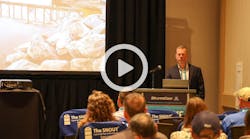
If there is an upside to the drought affecting many parts of the country, it may be that we’re learning how to save water and cut down on fertilizer use in ways that will continue even after the dry spell is over.
This article details some of the products and technologies that have been developed to limit agricultural water use. Some have actually been available for years but are only now in demand, as farmers are motivated to spend money to save water. One such product is the On Target Sprayer, which costs up to $50,000. The device “electrically charge[s] mists of pesticides and plant nutrients in a way that causes them to stick to leaves more evenly, using about 80% less water than conventional chemical-spray rigs.” Progressive Grower Technologies, which sells the device, says sales are growing at 30% a year.
If there is an upside to the drought affecting many parts of the country, it may be that we’re learning how to save water and cut down on fertilizer use in ways that will continue even after the dry spell is over. This article details some of the products and technologies that have been developed to limit agricultural water use. Some have actually been available for years but are only now in demand, as farmers are motivated to spend money to save water. One such product is the On Target Sprayer, which costs up to $50,000. The device “electrically charge[s] mists of pesticides and plant nutrients in a way that causes them to stick to leaves more evenly, using about 80% less water than conventional chemical-spray rigs.” Progressive Grower Technologies, which sells the device, says sales are growing at 30% a year. [text_ad] Other products include water-holding gels that are mixed into the soil to help retain water near plant roots, monitors to help detect leaks in irrigation systems, and sensors to help determine exactly how much water plants are using each day so farmers don’t overwater. The Center for Watershed Sciences at the University of California–Davis, has estimated that the drought in California will cause $2.7 billion in losses because of the half-million aces of fields farmers are leaving fallow. Those who are pushing the new technologies, though, say that they might reduce agricultural water use by as much as 25%, allowing farmers to produce more food with less water. The state’s entire agricultural economy represents about $45 billion a year.Other products include water-holding gels that are mixed into the soil to help retain water near plant roots, monitors to help detect leaks in irrigation systems, and sensors to help determine exactly how much water plants are using each day so farmers don’t overwater.
The Center for Watershed Sciences at the University of California–Davis, has estimated that the drought in California will cause $2.7 billion in losses because of the half-million aces of fields farmers are leaving fallow. Those who are pushing the new technologies, though, say that they might reduce agricultural water use by as much as 25%, allowing farmers to produce more food with less water. The state’s entire agricultural economy represents about $45 billion a year.About the Author
Janice Kaspersen
Janice Kaspersen is the former editor of Erosion Control and Stormwater magazines.


